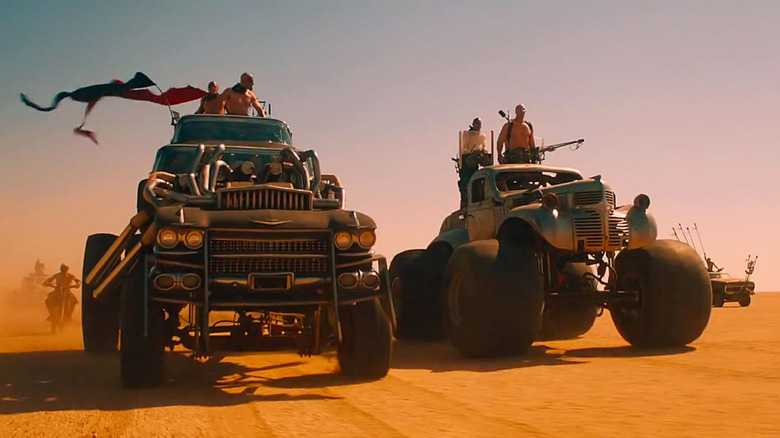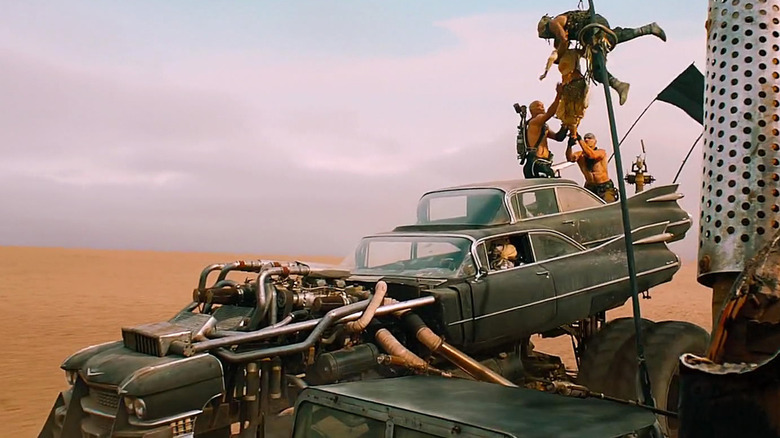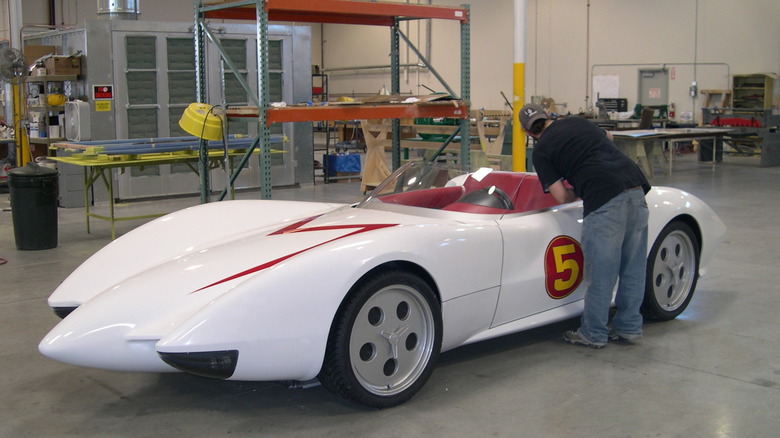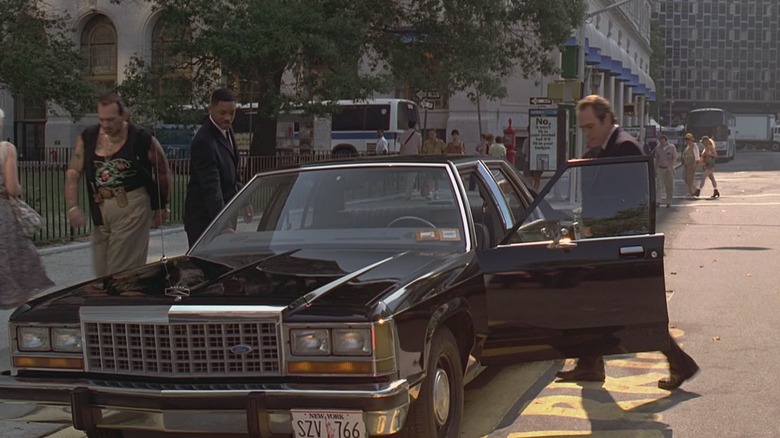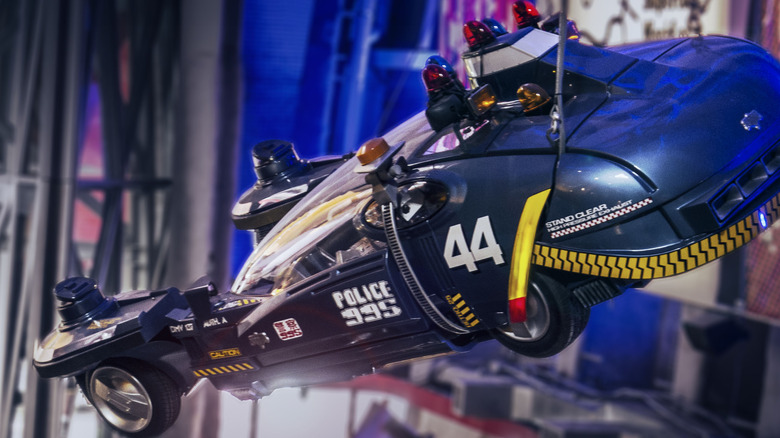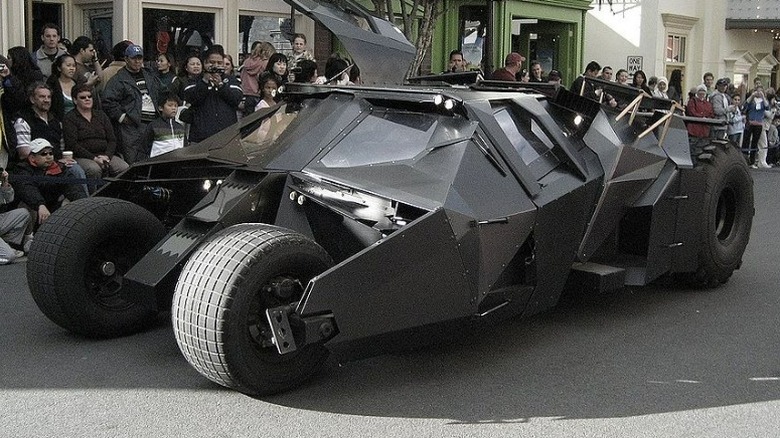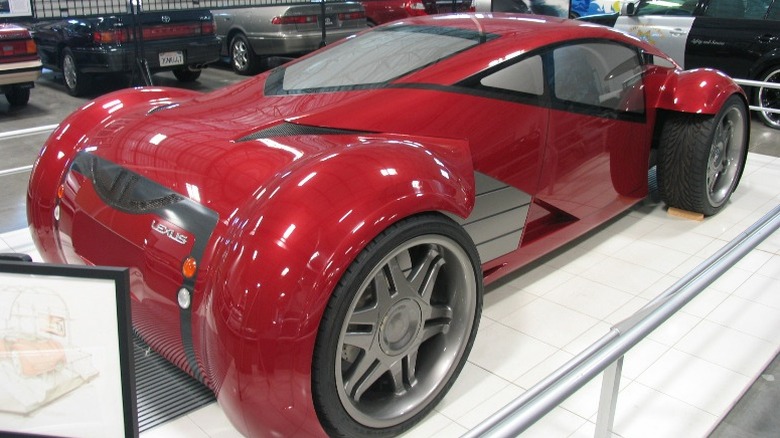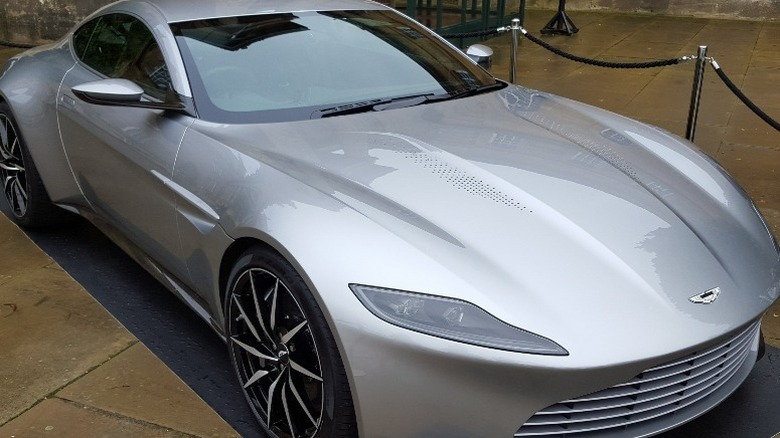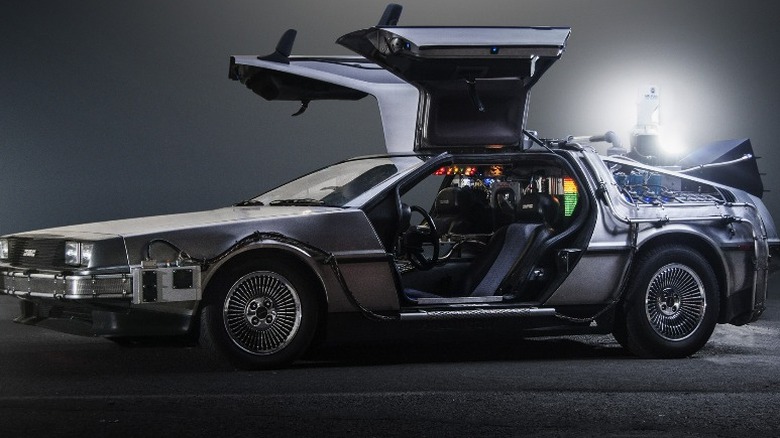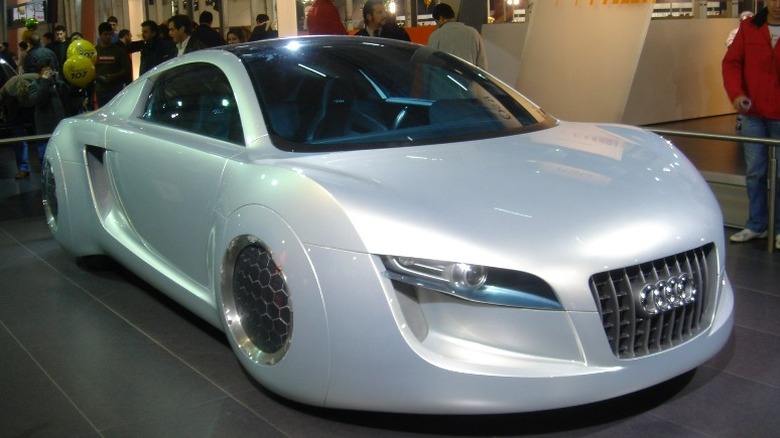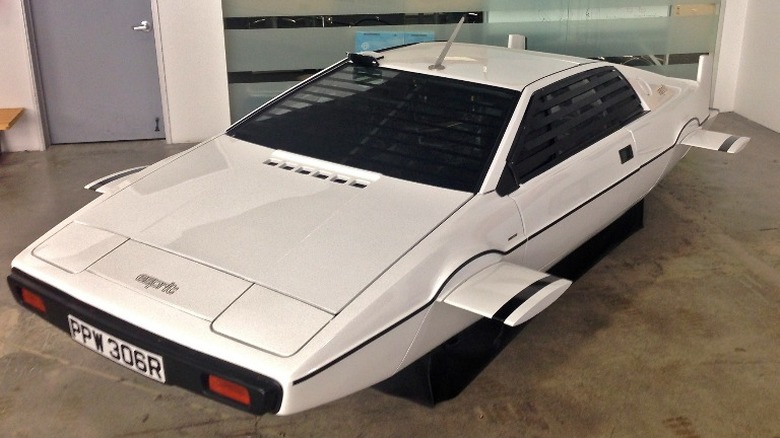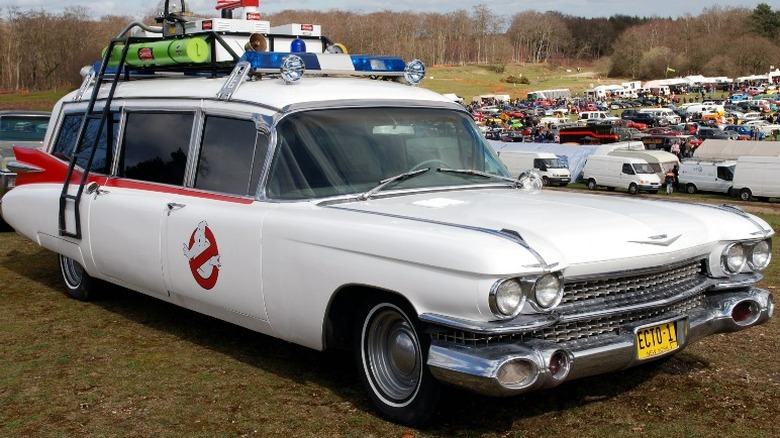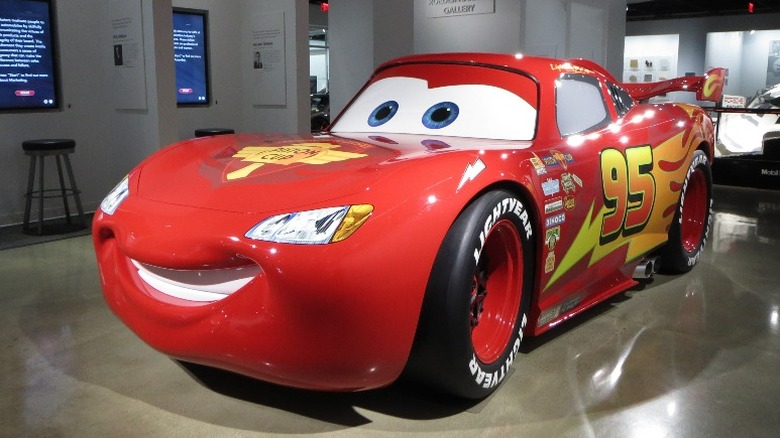12 Beloved Movie Cars That Aren't Possible In Real Life
Movies have a long history of featuring vehicles. They help period films create a feeling of the past, and nothing arouses movie nostalgia quite like the cars the characters drive. Cars are used in races, they get flipped over, blown up, driven off cliffs, or just host a conversation between the protagonist and an adversary. Vehicles can become crucial elements of character development, or even an extension of the characters themselves. In many films, vehicles are not just props, but can develop into well-known icons for the entire film.
While some cars seen in movies are production models that can be purchased at your local dealer, others are objects of fantasy, created solely for cinematic purposes. The often-quoted "It only happens in the movies" applies to these vehicles that are merely products of the imagination, and the sky is the limit. Some vehicles fly, transform into giant robots, change into submarines, or even take their passengers back to the future.
Some made-for-movies cars are modified versions of real vehicles that provide the protagonist with the tools needed to combat an adversary, such as the Aston Martin DB5 driven by James Bond in "Goldfinger." The British sports car featured revolving license plates, tire slashers, a smoke screen, front wing machine guns, a rear bullet-proof screen, and of course, an ejector seat. Other cars are designed and created specifically for the film, and are impractical or impossible to produce.
Here are 12 beloved movie cars that aren't possible in real life.
Gigahorse: Mad Max: Fury Road
Immortan Joe, the lord of the Citadel and the leader of the fanatical war boys, drives the Gigahorse, a custom vehicle (they are all custom) in the movie "Mad Max: Fury Road." The vehicle is built with two 1959 Cadillac Coupe de Villes, one sitting on top of the other supported by a custom chassis (via Car and Driver). The machine is powered by two Chevrolet 502-cubic-inch big block V8 crate motors, with fabricated manifolds and working 8-71 superchargers (8 cylinders, 71 cubic inches per cylinder), producing over 500 horsepower each (The Drive).
The film's original design called for two dummy fiberglass engines visible on the outside while a single working engine, hidden on the inside, powered the machine. However, production designer Colin Gibson decided an authentic vehicle would seem more realistic, so he added the budget to pay for it. The two V8 engines were initially connected through a custom gearbox adapter to a turbo 400 automatic transmission, but later changed to the heavier-duty Allison automatic truck transmission.
The production crew equipped the Gigahorse with custom rims and hubs made to accommodate the 70-inch-diameter rear tractor tires. Terex four-wheel drive front-end loaders supplied the differential and reducer systems (via Which Car?). Despite the powerful dual V8 engines, the massive hubs with a 16:1 drive ratio limited the top speed to 95 km/h, but Collin Gibson claimed the Gigahorse achieved speeds up to 125km/h (via autoevolution). The vehicle's durability in "Fury Road" was more important than speed, since most of the stunts were "real" without the aid of CGI.
Mach 5: Speed Racer
"Speed Racer," the anime about automobile racing, entertained children all over the world with an estimated 40 million viewers in the '60s and '70s. The animated tale of a teen racecar driver and his girlfriend is often remembered for its song lyrics, "Go, Speed Racer!" Even people who never watched an episode of "Speed Racer" are familiar with the program's name and the hero's car, the Mach 5.
The anime Mach 5 version boasted 5,000 horsepower distributed equally to each wheel via auxiliary engines (via Silodrome). The car featured seven buttons on the steering wheel hub that controlled various functions, including a button to employ powerful rotary cutter blades that protrude from the front of the car for removing obstacles, such as trees. Another button sealed the cockpit in an air-tight and water-tight chamber, making the driver invulnerable (via Jalopnik)
While no one can own a Mach 5, the product of a cartoon artist's wild imagination, several replicas have been made, some using a Corvette C4 chassis and drivetrain. Undoubtedly, the best-known version is the Mach 5 prototype on display at the Petersen Automotive Museum in Los Angeles.
[Featured image by Artie04 via Wikimedia Commons | Cropped and scaled | CC BY-SA 3.0]
Ford Crown Victoria: Men in Black
In the 1997 movie, "Men in Black," the alien hunters Agent K (Tommy Lee Jones) and Agent J (Will Smith) work for an agency that defends the earth from extraterrestrial worms, squids, giant cockroaches, and other partially human-looking beings. They drive the quintessential police car. Upon first seeing the vehicle, J comments, "Unlimited technology from the whole universe, and we cruise around in a Ford P.O.S."
The non-threatening 1987 Ford LTD Crown Victoria lacked even the slightest shred of vitality or glamour. However, the car's clean and simple style fit Tommy Lee Jones' demeanor perfectly: plain and purposeful without extravagance on the outside. In its auxiliary operating mode, activated by a red button, the sleeper sedan blew away everything in its path. In one scene, twin exhaust thrusters appeared in the rear, propelling the vehicle at nearly supersonic speeds, defying gravity by riding along the roof of the Midtown Tunnel, essentially "flying" above the traffic below.
The LTD is seen in various episodes of the science fiction comedy film series. Released in 1997 with a budget of $90 million, the film grossed $587 million worldwide, making it the third-highest-grossing film of the year behind "Titanic" and "The Lost World: Jurassic Park." For the enthusiast who would like to own one of the "Men in Black" Ford Victorias, there are plenty available. Ford produced 128,878 of these full-size vehicles in coupe, sedan, and station wagon body styles (via Smartway).
However, none of them will have the little red button.
Spinner: Blade Runner
Rick Deckard (Harrison Ford) is a police officer who hunts down illegal bioengineered humanoids called "replicants" in the 1982 sci-fi movie "Blade Runner," directed by Ridley Scott. He drives (and flies) a car nicknamed the "Spinner." Renowned artist and visual futurist Syd Mead designed the Spinner along with several other vehicles for the film. In "Blade Runner," the Los Angeles Police Department uses the Spinner's street capability, flying, and hovering features for traversing the towering and rambling Los Angeles of the future. In the film, most of the large buildings have roof landing pads to accommodate flying vehicles, making it easy for the police to patrol the overcrowded streets.
Designer Mead described the Spinner as an aerodyne, a vehicle that directs air downward to create lift. In the film, the vehicle was propelled by three engines: conventional internal combustion, jet propulsion, and a vague system of anti-gravity propulsion that is common in many science fiction franchises.
In 1982, the Spinner gave us a glimpse into a future with flying cars. Today, vertical take-off and landing (VTOL) aircraft using directed jet propulsion to take off vertically, hover, and cruise are available, but none of them use an anti-gravity system for flying. Most are single-pilot vehicles that bear no resemblance to the "Spinner." A Spinner is currently on display in a permanent exhibit at the Science Fiction Museum and Hall of Fame in Seattle, Washington.
[Featured image by Tydence Davis via Wikimedia Commons | Cropped and scaled | CC BY 2.0]
Batmobile: Dark Knight Rises
Hollywood has produced several versions of the Batmobile since the car was featured in the live-action TV series aired in the 1960s. Although the first crime-fighting car was based on a 1950s Lincoln concept vehicle, most of the subsequent vehicles bear no resemblance to a production car. The Tumbler, from the movie "Dark Knight Rises," is arguably one of the most unique.
Production designer Nathan Crowley and director Christopher Nolan designed the all-new Batmobile with minimal use of computer-aided design tools. Instead, they conceptualized the vehicle by assembling parts from several plastic toy model kits to create six cars with a scale of roughly 1:12. The process took four months, and concluded with the creation of a hand-carved, full-scale model made from styrofoam that served as a form to make wooden molds for the 56 body panels (via Jalopnik).
The finished product measured 9 feet wide and 15 feet long. The tube-frame chassis and carbon fiber body panels kept the weight down to 2.5 tons (a GMC Hummer weighs about 4.5 tons, by comparison). According to batmobilehistory.com, an impressive Chevy 350 V8 engine that generates 500 horsepower pushes the Tumbler to 60 mph in less than six seconds, with a top speed of 110 mph. Its unique design provided the strength required to consistently endure jumps of up to 30 feet without being damaged. The studio built four vehicles, each costing about $250,000. Two race versions were used for action shots, one with an elaborate cockpit, and one had a jet engine bolted to the back.
[Featured image by spud murphy via Wikimedia Commons | Cropped and scaled | CC BY-SA 2.0]
Lexus 2054: Minority Report
In 2002, Steven Spielberg asked the luxury automaker, Lexus, to design a vehicle that would fit the requirements of the year 2054 for his movie adaptation of the 1956 short story, "Minority Report," starring Tom Cruise. The concept car, designed by Harald Belker, is a muscular high-performance two-seat sports car with cab-forward seating, a low, enclosed wheelbase, and aggressive lines. At first glance, the proportions are so unique, that it's not obvious which end is the front, and which is the rear.
Named for the year in which the movie takes place, the Lexus 2054 was a project car, although it lacked all the gadgets and gimmicks of the movie version. The "Minority Report" car was autonomous, had a verbal interface, and played music to match the mood of the driver. In the film, the vehicle was first shown being built at an automated factory, and later driven by Tom Cruise in several action sequences.
Car and movie buffs can purchase a street-legal "Minority Report" 2054 replica. Powered by a Porsche 2.7-liter V6 with custom headers and exhaust, the 2016 Vetter Custom Dimensia features creature comforts and upgrades you would expect from a one-off vehicle. While the car is not the Lexus 2054 from "Minority Report," it might be the closest imitation.
[Featured image by ilikewaffles11 via Wikimedia Commons | Cropped and scaled | CC BY 2.0]
Aston Martin DB10: Spectre
James Bond has driven a variety of cars since the release of "Dr. No" in 1962. These vehicles included a BMW Z8, Toyota 2000 GT, Ford Mustang, Lotus Esprit, and many more (via Sixt). But perhaps the most recognized car is the Aston Martin DB5 from the movie "Goldfinger." For the movie "Spectre," 007 also drove an Aston Martin, but the automaker designed the DB10 specifically for the film, and it is unlikely it will ever go into full production.
Aston Martin built eight DB10s for use in the film, plus two cars made for promotional purposes. Two of the cars used an external driving pod, allowing a stunt driver to control the car on the roof while Daniel Craig simulated driving behind the wheel. Two of the DB10s were fully equipped cars with production-ready interiors, customized wheels, and clean exteriors sans rigging and Q gadgets (via MotorTrend). Bond's famed DB10 had a number of memorable features, including:
- Two powerful flamethrowers mounted in the exhausts.
- A rear-mounted double barrel machine gun hidden behind the Aston Martin badge.
- A body and windows made with materials that withstand impact damage from conventional firearms.
- A driver ejector seat with a parachute.
One of the promotional Aston Martins sold at auction in 2016 for $3.5 million.
[Featured image by DeFacto via Wikimedia Commons | Cropped and scaled | CC BY-SA 4.0]
DeLorean DMC-12: Back to the Future
The DeLorean DMC-12 is a two-seater, rear-engine sports car manufactured by John DeLorean's DeLorean Motor Company from 1981 until the 1983 model year. According to MotorTrend, the automaker produced nearly 9,000 DMC-12s before production halted in late 1982, and today, an estimated 6,500 DeLorean Motor cars still exist. While an interested buyer can still purchase a previously owned DMC-12, one with the features found on the time-travel vehicle seen in the movie "Back to the Future" is unavailable.
With the stainless-steel body, a rear-mounted 2.8-liter engine producing 130 horsepower and 153 pound-feet of torque, and gull-winged doors, the '80s DeLorean DMC-12 was a showpiece without performance (via Automotive Heritage Foundation). The production crew of "Back to the Future" adorned the movie-version DeLorean exteriors with several parts, including hydraulic tubes, wiring harnesses, and electrical boxes. They added two massive, square vent boxes, similar to rocket nozzle exhausts, on the posterior. A "plutonium chamber" was mounted where the car's rear hatch would be. The device was later replaced by a "Mr. Fusion Home Energy Reactor" (the art department made it from a Krups Coffina coffee grinder) (via Street Muscle Magazine).
Inside, the modifications included the legendary "flux capacitor" that generated the 1.21 gigawatts of power needed to reach a velocity of 88 mph, and initiate time travel. Produced by Steven Spielberg's Amblin Entertainment, "Back to the Future" is one of the most successful films of all time, initiating a franchise with two sequels, several spinoffs, theme park rides, video games, and an enormous merchandising market.
[Featured image by Oto Godfrey and Justin Morton via Wikimedia Commons | Cropped and scaled | CC BY-SA 4.0]
Audi RSQ: I, Robot
In 2004, Audi built the RSQ as a concept car for the science fiction movie "I, Robot," which stars Will Smith. The futuristic car predated the R8 by a couple of years, and it is no coincidence that the two cars share a similar body style. The film takes place in the year 2025. Chicago's police officers race through the city in two-seater, mid-engined sports cars that contact the roads on sphere-shaped wheels. Similarly sculpted arches cover the wheels, enhancing the car's futuristic character. Julian Hanig, the RSQ exterior designer, said "Integrating these spheres into the car's design was one of the greatest challenges we had to solve."
According to Supercars.net, Audi designers, engineers, and technicians designed and built the concept car in just 10 weeks. The angular body cutouts hosting the head-light modules, side air inlets, and the intensely bright xenon light tubes behind the clear-glass covers define the character of the car's front end. The RSQ exterior is also highlighted by the gull-wing doors rear-hinged to the C-posts of the body. Whenever Will Smith gets into or out of the car, the doors open upwards, and twist slightly like a butterfly's wings.
Audi designed the RSQ interior with a jet aircraft's cockpit configuration, including only the essential components for driving. The pilot sits in a bucket seat surrounded by the center console, and the steering wheel is open at the top and folds out of the instrument panel once the driver is seated in the car.
[Featured image by Georgios Pazios via Wikimedia Commons | Cropped and scaled | Attribution only]
Lotus Esprit: The Spy Who Loved Me
In 1977, for the movie "The Spy Who Loved Me," James Bond's Lotus Esprit S1 featured wheels that rolled back, replaced by fins that transformed the car into a submersible. But the vehicle was much more than a fancy submarine. In the late '70s, the Lotus Esprit S1 was Britain's most advanced sports car, powered by a 2-liter inline 4-cylinder engine producing 160 brake horsepower at 6,200 revolutions per minute, and 140 pound-feet of torque at 4,900 revolutions per minute. According to Supercars.net, the car accelerated to 60 mph in 8.4 seconds, and reached a top speed of 138 mph. Its sleek appearance and lowered fiberglass body mounted on an F1-derived chassis and suspension made it the ideal car to distinguish the Roger Moore James Bond character from a previous 007 spy played by Sean Connery, who drove an Aston Martin DB5.
In 1977, an aquatic, watertight car was a reality (via Silodrome). Perhaps the best known was the Amphicar, an amphibious craft that floated like a boat, but had no submergible capability. Furthermore, the Amphicar lacked the suave appearance suitable for a debonair British secret service agent. Even a sophisticated English gentleman spy cannot make a floating bathtub look threatening. The sleek aerodynamic lines of the Lotus Esprit S1 gave the sports car the perfect look transforming into a streamlined submarine. While previous Bond cars boasted a plethora of gadgets, the Lotus Esprit S1 had only the oil slick (from the DB5), and a rear-mounted concrete sprayer. But the underwater capability was the only one it needed to escape the bad guys.
[Featured image by Steve Jurvetson via Wikimedia Commons | Cropped and scaled | CC BY 2.0]
Ectomobile, 1959 Cadillac Miller-Meteor: Ghostbusters
Perhaps the most recognizable movie car of all time is the ECTO-1 from the original 1984 film "Ghostbusters," and other Ghostbusters fiction. Based on a 1959 Cadillac Miller-Meteor Futura, the hearse and ambulance combination with limousine-style windows was refurbished to carry the ghost-capturing team and their equipment throughout New York City.
In the movie, Dr. Ray Stantz (played by Dan Aykroyd) purchased the vehicle in a poor state of repair for the surprisingly high price of $4,800. However, Stantz jokingly downplayed the repairs saying it only needed "suspension work and shocks, brakes, brake pads, linings, steering box, transmission, rear-end, new rings, mufflers, and a little wiring."
The Ghostbusters team refurbished the Cadillac hearse-and-ambulance combination for carrying their equipment, adding a modified gurney that held the proton packs and rolled out from the back door, making it easier to retrieve them. Blue emergency lighting was installed, and the siren used a modified leopard snarl played backward.
The movie production crew added several other gadgets to the side and roof of the car, but the movie never identified or explained their purpose. These included muon scrubbers (muons are fundamental subatomic particles, like electrons, but weigh more than 207 times as much), a radio GPS locator, high-intensity microphones, and EMF scrubbers. Cadillac limited the production of Miller-Meteor models to 400 vehicles (via Code 3 Garage). Although rare, a collector could find one for sale, but it would lack all the Ghostbuster upgrades that made the movie vehicle unique.
[Featured image by Allen Watkin via Wikimedia Commons | Cropped and scaled | CC BY-SA 2.0]
Lightning McQueen: Cars
Lightning McQueen is the arrogant, over-confident protagonist of Pixar's "Cars" franchise, set in a world of humanlike talking cars. The animators sourced several car brands to create McQueen's design, the most influential being the Chevrolet Corvette C1 (1953-1962) and the Chevrolet Corvette C6 (2004-2013) (via Way.com). Other influential cars include the Dodge Charger, Plymouth Road Runner Superbird, Porsche 911, and Ford GT40.
McQueen is a rookie race car, voiced by Owen Wilsen, competing in the fictional Piston Cup Circuit (inspired by the real-world NASCAR Circuit). The car is known for his signature slogan "Ka-chow!" uttered whenever he impresses the crowd with his driving skills. In the Pixar movies, Lightning McQueen is painted red with yellow lightning bolts on the sides. He has a rear spoiler, the number 95 displayed in orange on his body, and NASCAR-style wheels. While the actual design of the character is obvious, what lies under the hood is a complete mystery.
When Disney released Pixar's "Cars 2" in 2011, the company provided real-world specifications for the vehicles to which most car enthusiasts can relate. The movie's hero, Lightning McQueen, is equipped with a V8 that generates 750 horsepower, and can accelerate to 60 mph in a mere 3.2 seconds on its way to a top speed of 200 mph. Not bad for a cartoon character! Then again, performance specs are only limited by the producer's imagination.
One thing is certain: A talking car is not possible in real life.
[Featured image by zombieite via Wikimedia Commons | Cropped and scaled | CC BY 2.0]
